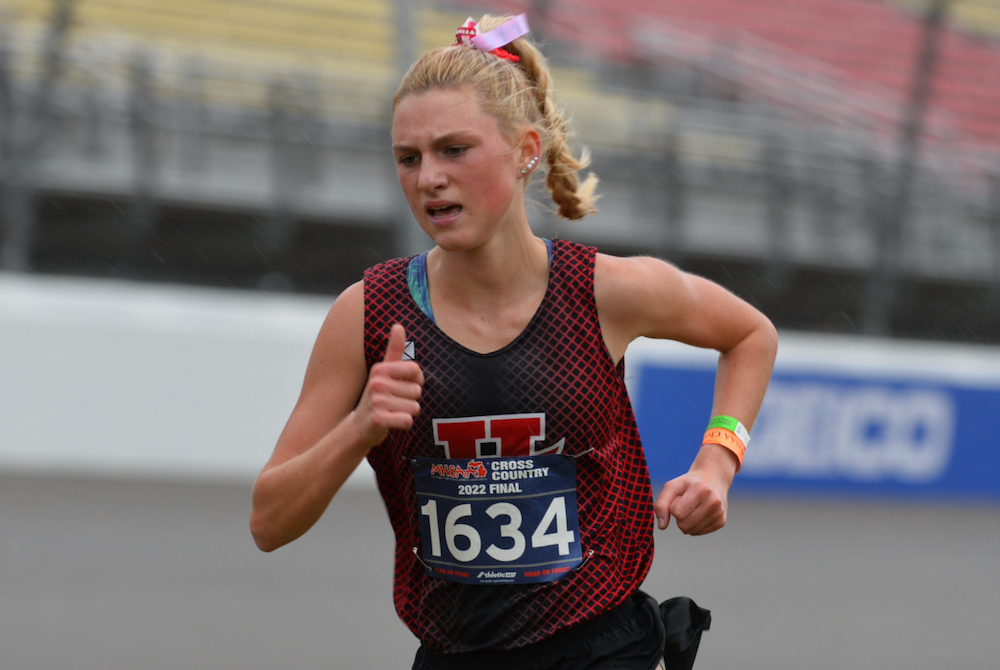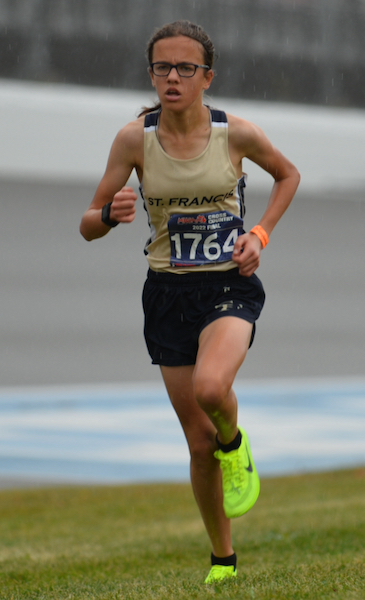
Theis, EGR Forge Championship Paths
November 3, 2018
Second Half reports
BROOKLYN — The crown is staying in the family.
One year after Lansing Catholic’s Olivia Theis ran the fastest time ever at the MHSAA Girls Cross Country Finals, her sister assumed her vacated Lower Peninsula Division 2 title Saturday at Michigan International Speedway.
Cougars junior Jaden Theis won with a time of 18:01.9, finishing 14.6 seconds ahead of Makenna Veen of Plainwell.
The first three finishers were juniors. There were no seniors in the top 11.
“I’ve got to keep the tradition going,” Theis said. “It just feels really good to keep the last name out there ruling D2.”
Last year, Olivia Theis set the Finals record with a time of 16:52.1, breaking a mark held by 2009 Foot Locker national champion Megan Goethals of Rochester. So, it helped that Jaden didn’t have to contend with her sister this year. It also helped being healthy.
“I was sixth last year,” she said. “My ankle was bothering me.”
Jaden had the benefit of getting sisterly advice from an MHSAA record holder.
The advice?
 “Just stay calm, relax, have fun out there,” Jaden said. “I wasn’t too worried about time today, knowing the course conditions. I’m happy with it.”
“Just stay calm, relax, have fun out there,” Jaden said. “I wasn’t too worried about time today, knowing the course conditions. I’m happy with it.”
Veen has finished in the top five three times at MIS, with one season remaining. She was fourth as a freshman, fifth as a sophomore and second this year.
“I honestly didn’t expect to place as well as I did,” Veen said. “But I race well in these nasty conditions.”
East Grand Rapids won the team championship in commanding fashion, scoring 51 points to win by 108 over runner-up DeWitt. The Pioneers had their five scoring runners across the line before DeWitt got its second finisher.
All five of East Grand Rapids’ scorers made all-state by placing in the top 30. Junior Margaret Coney was fifth in 18:38.2, freshman Ainsley Workman was 11th in 18:51.2, junior Katie Hessler was 15th in 18:56.6, junior Anna Petr was 20th in 19:02.8 and senior Audrey Whiteside was 21st in 19:04.4.
The Pioneers moved back to Division 2 after placing 13th in Division 1 last year. Their times Saturday would’ve made them competitive with Division 1 champion Clarkston. Clarkston’s first two runners were faster than East Grand Rapids’ by considerable margins, but the Pioneers had the advantage by close margins with their third, fourth and fifth runners. The teams would’ve tied, 147-147, if East Grand Rapids ran the same times in Division 1, with Clarkston winning the sixth-runner tie-breaker.
It was the sixth MHSAA Finals championship for East Grand Rapids, which last won in 2011.
PHOTOS: (Top) Lansing Catholic’s Jaden Theis comes around a bend during the Division 2 Final on Saturday at MIS. (Middle) East Grand Rapids’ Katie Hessler (1334), Anna Petr (1335) and Audrey Whiteside run as part of a pack early in the Division 2 Final. (Click for more from RunMichigan.com.)

Jazwinski Brings Hart Individual Title as St. Francis Moves to Front of Team Pack
November 5, 2022
BROOKLYN – Cross country races can be won between the ears before runners ever step foot onto the course.
Attitudes were tested as rain began to descend on Michigan International Speedway and the wind picked up just before the start of the MHSAA Lower Peninsula Division 3 girls race late Saturday morning.
Hart sophomore Jessica Jazwinski was loving life as she prepared to race.
“As a distance runner, I really try to love the wind,” she said. “Distance running and cross country is just a tough sport. The wind just adds to it — and the rain, too. It’s super fun.
“I was just thinking these conditions are just gonna feed my great race. This is real cross country. Yeah!”
Jazwinski overcame the elements to run the fifth-fastest Division 3 time ever, winning with a time of 17:36.70. She has two of the top-five times in Division 3 Finals history, having run 17:31.4 to place third last year.
“Today my race plan was just to go out hard and try to hold on to my pace,” she said. “I feel like I tried to race a lot like Steve Prefontaine, just go out and hold on.”
 Lansing Catholic senior Hannah Pricco was second in 18:17.59, Onsted sophomore Emmry Ross was third in 18:20.96 and Hart junior Alyson Ens was fourth in 18:28.52.
Lansing Catholic senior Hannah Pricco was second in 18:17.59, Onsted sophomore Emmry Ross was third in 18:20.96 and Hart junior Alyson Ens was fourth in 18:28.52.
“I love having great teammates to work with and encourage each other,” Jazwinski said. “We really try to encourage each other so much throughout the races. Throughout this year, some races she’s been a minute behind me, some races she’s been five seconds. I don’t want her to ever beat me, so that pushes me so much. I know she’s trying to race me and get up there with me.”
The only downer for Hart was having its string of Division 3 championships end at five with a fourth-place finish. Hart had two runners in the top four, but its No. 3 runner was 68th.
“I would totally trade my individual title for a team title,” Jazwinski said.
Traverse City St. Francis emerged from a close battle to win its first title since 2016 with 134 points. Pewamo-Westphalia was second with 142 and Lansing Catholic third with 165.
Sophomore Betsy Skendzel led St. Francis, placing seventh in 18:48.33. Completing the team score were senior Sophia Rhein in 26th (19:43.27), sophomore Grace Slocum in 33rd (20:07.95), junior Rylee Duffing in 60th (20:44.82) and junior Margot Hagerty in 63rd (20:45.78).
Lansing Catholic had three place in the top 10, but didn’t get another finisher until 103rd.
PHOTOS (Top) Hart’s Jessica Jazwinski pushes toward the finish during Saturday’s LPD3 Final. (Middle) Traverse City St. Francis’ Betsy Skendzel leads the way for the eventual team champion. (Click for more from Dave McCauley/RunMichigan.com.)

